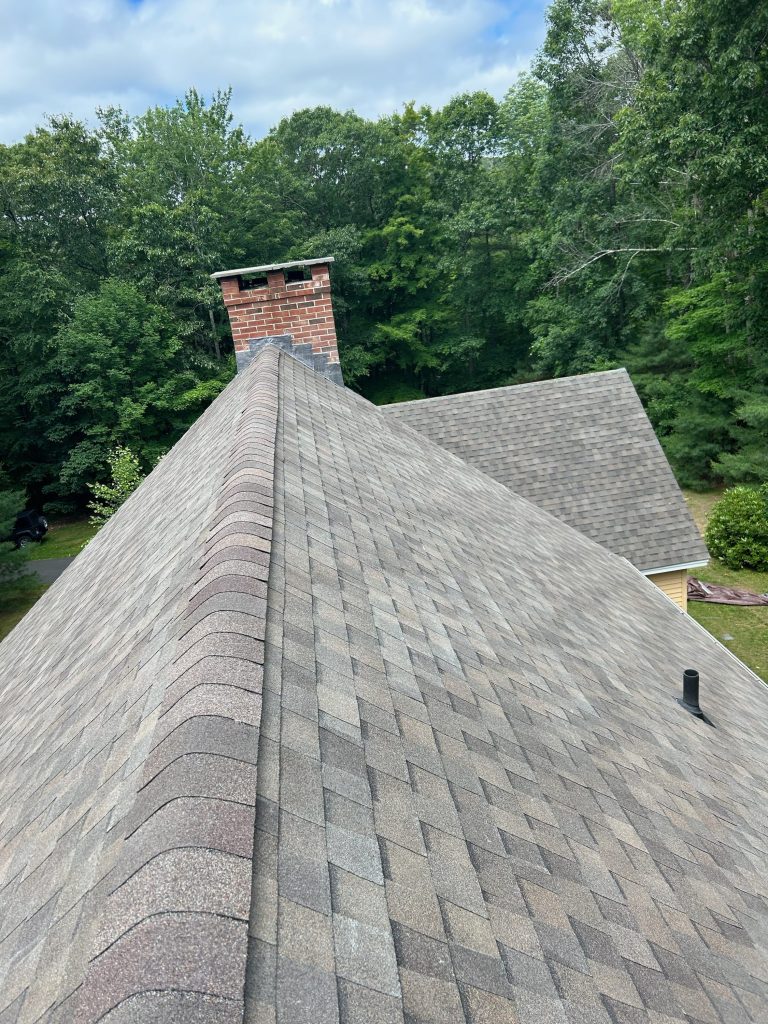Understanding Roof Flashing: Your Home’s First Line of Defense Against Leaks
Picture this: You’re relaxing at home after a heavy rainstorm when you notice a suspicious water stain spreading across your ceiling near the chimney. If this sounds familiar, there’s a good chance your roof flashing might be the culprit.
Roof flashing might not be the most glamorous part of your home, but it’s one of the most critical components in keeping water where it belongs – outside. This thin layer of material acts like a raincoat for your roof’s vulnerable spots, directing water away from areas where leaks love to start.
For Connecticut homeowners, understanding roof flashing is especially important. Our state’s weather throws everything at our roofs: harsh winter freezes, spring downpours, summer humidity and fall nor’easters. Your roof flashing works overtime through all four seasons to protect your home from water damage.

What Exactly Is Roof Flashing?
In the simplest terms, roof flashing is a thin piece of metal installed at the joints and edges of your roof. Think of it as the caulking around your bathtub, but for your roof – it creates a watertight seal wherever two surfaces meet or wherever there’s an opening in your roofing system.
While your shingles do an excellent job of shedding water on the flat planes of your roof, they can’t protect every area. Anywhere your roof changes direction, meets a wall, or has a penetration (like a chimney or vent pipe), you’ve got a potential entry point for water. That’s where flashing steps in.
The key difference between flashing and other waterproofing methods is its durability and ability to handle movement. Unlike sealants that can crack or degrade over time, properly installed metal flashing expands and contracts with temperature changes while maintaining its protective barrier.
If you’re concerned about other potential weak points in your roofing system, check out our guide on the top 11 residential roofing problems homeowners face.
Where Does Roof Flashing Go? Critical Areas That Need Protection
Not all parts of your roof need flashing, but the areas that do are absolutely critical. Here are the most common locations:
Chimneys are probably the most recognizable spot for roof flashing. Since your chimney creates a large opening in your roof, it needs protection on all four sides.
Roof valleys are where two sloping roof planes come together, creating a V-shaped channel. Think of these like natural gutters on your roof – water flows down both planes and converges in the valley.
Skylights have become increasingly popular, bringing natural light into Connecticut homes. But every skylight requires careful flashing installation around all four sides to prevent leaks.
Vent pipes and stacks stick up through your roof for plumbing and ventilation. Each penetration needs a specialized flashing boot or collar that creates a seal around the pipe.
Dormers and walls create vulnerable spots wherever your roof meets a vertical wall. Step flashing is typically installed along these intersections to direct water downward and away from the seam.
Eaves and rakes refer to the edges of your roof. Drip edge flashing is installed here to direct water away from the fascia boards and into your gutters. If you’re curious about what a rake is exactly, we’ve got a detailed explanation in our guide on understanding the rake of the roof.
Types of Roof Flashing Materials: What’s Protecting Your Home?
Different materials offer different benefits, and the right choice depends on your budget, roof type and long-term goals.
Aluminum flashing is one of the most popular choices for residential roofing. It’s lightweight, relatively affordable and resistant to rust. Most homeowners can expect aluminum flashing to last 20 to 30 years with proper maintenance.
Copper flashing is the premium option that many homeowners choose for its distinctive appearance and exceptional longevity. While copper costs significantly more upfront, it can last 50 to 100 years or more. Over time, copper develops a beautiful green patina.
Galvanized steel flashing offers an excellent middle ground between affordability and durability. It’s stronger than aluminum and less expensive than copper, typically lasting 30 to 50 years depending on your local climate.
For homes in Connecticut, where we deal with significant temperature swings and freeze-thaw cycles, most professional roofers recommend either aluminum or copper depending on your budget. Both materials handle our climate well and integrate seamlessly with common roofing materials.
Speaking of roofing materials, our guide on how to find the right roofing material can help you make an informed decision. The National Roofing Contractors Association also provides excellent resources on matching flashing materials to different roofing systems.
How Roof Flashing Works to Prevent Leaks
The basic principle is simple: flashing directs water away from vulnerable areas and channels it safely down and off your roof. Professional roofers install flashing so that each piece overlaps the one below it, just like shingles. Water flows downward by gravity, hitting each piece of flashing and being directed further down until it reaches your gutters.
But flashing alone isn’t a magic solution – it must be installed correctly to work. Even the highest-quality copper flashing will fail if it’s not properly integrated with your roofing system or doesn’t have adequate overlap.
Connecticut’s weather makes proper flashing installation even more crucial. Our freeze-thaw cycles can be particularly brutal. When water gets into small gaps and freezes, it expands, making those gaps larger. Ice dams – a common winter problem here – put enormous stress on flashing, especially around eaves and valleys. Heavy rain and nor’easters test your flashing differently, driving water horizontally against surfaces where it wouldn’t normally go.
The Connecticut State Building Code includes specific requirements for flashing installation to address these local weather challenges.
Common Roof Flashing Problems Connecticut Homeowners Face
Even the best flashing won’t last forever. Here are the warning signs to watch for:
Water stains on ceilings or walls are often the first sign homeowners notice, particularly near chimneys or skylights. Rust or corrosion visible on the flashing itself is a clear warning sign. Loose or missing flashing pieces might be visible from the ground, especially after major storms. Cracks or holes in the material can develop over time. Separated seams or gaps indicate that sealant has failed or the flashing has shifted. Moisture in the attic is sometimes the first place water damage shows up.
What Causes Flashing Failure?
Age and weather exposure are the most common reasons flashing fails. Most flashing will last 20 to 30 years, but harsh Connecticut conditions can shorten that lifespan. Improper installation leads to premature failure. Storm damage from fallen branches or extreme winds can tear or dislodge flashing. Thermal expansion and contraction over thousands of cycles can work fasteners loose. Ice dam damage is a particular concern in Connecticut, as ice can push up under shingles and flashing.
If you’re noticing any of these warning signs, read our article on 5 signs it’s time to replace your roof and our guide to essential roof maintenance for Connecticut homeowners.
Why Professional Installation Matters
While we admire the DIY spirit, roof flashing is one area where professional expertise truly makes a difference. The complexity of proper flashing installation goes far beyond simply nailing metal to your roof. Professional roofers understand how different flashing types work together and how to create the overlapping layers that actually keep water out.
Connecticut building codes specify exactly how flashing must be installed. Professional roofers stay current with these requirements – which matters not just for protection, but also for insurance claims and home resale value. The International Code Council sets many of the standards that local codes are based on.
Experience with Connecticut’s weather patterns is another crucial factor. A roofer who understands how nor’easters drive rain and how ice dams form can install flashing systems that address these specific challenges.
Common DIY mistakes can be expensive to fix. We’ve seen homeowners use incompatible metals that corrode, install flashing over damaged underlayment, or skip critical overlap areas. These shortcuts might seem to work at first, but they fail quickly – often requiring complete reinstallation plus repair of any water damage.
When to Have Your Flashing Inspected
After severe weather like heavy storms, hurricanes, or significant snowfall. During regular roof inspections at least once a year, ideally in the spring or fall. When getting a new roof installed – flashing often needs to be replaced along with the roof itself. If you notice any warning signs like water stains or visible rust. Before buying or selling a home. After roof repairs in adjacent areas to verify that flashing is still properly sealed.
Protecting Your Westbrook Home: Roof Flashing and Leak Prevention
Proper flashing is one of the best investments you can make in protecting your home. When it’s doing its job correctly, you’ll never think about it. But when it fails, the consequences can be expensive – from water-damaged ceilings to rotted roof decking and mold growth.
The good news is that flashing problems are preventable. Regular inspections, prompt repairs, and professional installation all add up to a roofing system that protects your home for decades.
Here in Westbrook and throughout Connecticut’s shoreline communities, our homes face unique challenges. Salt air, coastal storms, freeze-thaw cycles, and humid summers all test our roofing systems. That’s why working with a roofing contractor who understands these local conditions is essential.
At Nor’East Exteriors, we’ve been protecting Connecticut homes for years, and we understand exactly what it takes to keep water out through every season.
Schedule Your Professional Roof Inspection Today
Don’t wait for a leak to find out your flashing needs attention. By the time water stains appear on your ceiling, damage has already been happening behind the scenes.
The smart approach is proactive inspection and maintenance. Whether you’re concerned about the age of your roof, you’ve noticed warning signs, or you simply want peace of mind, now is the time to act.
Nor’East Exteriors has been serving Westbrook and surrounding Connecticut communities with professional roofing services that homeowners trust. We understand the unique challenges that coastal New England weather presents, and we know how to install and maintain flashing systems that stand up to everything our climate throws at them.
Ready to protect your home? Contact Nor’East Exteriors today:
Call us at (860) 256-8478 to speak with one of our roofing experts, or request your free estimate online.
Your roof flashing is a small component that makes a huge difference. Let’s make sure it’s doing its job – before water damage becomes your wake-up call.

